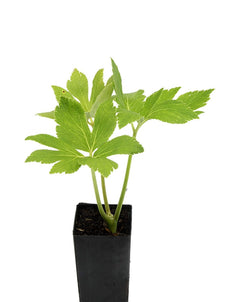
Ashitaba
Ashitaba

- In stock, ready to ship
- Inventory on the way

Usually available: All year
Life cycle: Biennial
Height: 1.5 - 2m
Position: Sun / part shade
Soil preference: Moist / well drained
This is how we pack and send your Herb Plants to all states except TAS & WA
You will receive
- 1 Ashitaba Herb Plant in a 50 X 75mm tube - General growing instructions
All of our Herb Plants are grown organically with certified organic potting mixes and fertilizers
Botanical Name: Angelica keiskei koidzumi
Ashitaba is a biennial plant flowering in its second year in summer. It can grow 1.5m - 2m high and just over a metre wide. The stout stems grow in a rosette and are long with the leaves forming towards the top of the stems. They are slow growing at first but once established they grow really quickly.
It has been known as Longevity Herb as traditionally it has been used as a rejuvenating food that contributes to long life. It is also called Tomorrow's Leaf because when harvesting one leaf from the plant, you can expect to see a new one tomorrow. The plant does rejuvenate itself quickly although I would not take a stem from one plant each day as it takes a few days for the new stem to reach a decent size.
Ashitaba is native to Hachijo-jima Island in Japan and is cultivated in the southern parts and Islands of japan. It was thought that Ashitaba was the reason for the long lives of the people of Hachijo-jima Island, something that may be based on its substantial levels of vitamin B12 and on the chalconoids that are unique to this species of angelica. During the Edo period the yellow sap was effectively used in the external treatment of smallpox, which prompted Kaibara Ekken to describe the herb in his Yamato honzō (Medicinal Herbs of Japan), under the name of ashitagusa, as ‘a powerful tonic drug.’ In folk medicine it is claimed to be diuretic, tonic, to improve digestion, and, when applied topically, to speed wound healing and prevent infection. Its nutritive qualities were said to be the reason that the internal exiles and their families had a endless supply of stamina in the face of their arduous compulsory labor.
The stems and leaves can be used in smoothies, salads and as a tea. In Japan they use the stems, leaves and taproots in regional cuisine, where they are prepared as soba, tempura, shōchū, tea, ice cream, etc.
Ashitaba has many claimed health benefits. It is high in chlorophyll and contains substantial levels of B12 along with other vitamins and minerals making it a nutritious plant. Ashitaba also contains chalcones, these are found in the yellow sap which is clearly visible when you slice the stem. Chalcones and their derivatives demonstrate wide range of biological activities that make this herb effective in treating eczema and psoriasis, also disorders of the gastrointestinal system, hepatitis, high blood pressure, chronic fatigue and a wide range of other disorders. In-vivo tests of chalcones have shown strong antibiotic activity against staphylococcus. For those of you who enjoy butterflies in the garden the common yellow swallowtail enjoy feeding on this plant.
Ashitaba prefers rich deep soil, well-drained and will grow in full sun to part shade. Regular watering will ensure plenty of leaf growth. They need at least 6 hours sunlight daily to thrive! You can fertilize with organic compost every 3 weeks.
All information provided on this website is for informational purposes only. Please seek professional advice before commencing any treatment.




